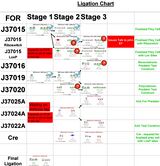BioSysBio:abstracts/2007/iGEM2006 Imperial College
Engineering a synthetic molecular oscillator based on the Lotka-Volterra dynamic.
Author(s): I. CoLi Team 2006 - Christin Sander, Farah Vohra, John Chattaway, Tom Hinson, John Sy, Jiongjun Bai, Jonathan Wells, Deepti Aswani, Vincent Rouilly, Chueh-Loo Poh, Matthieu Bultelle, Kirsten Jensen, David Mann, Paul Freemont, Richard Kitney.
Affiliations: Imperial College London, UK
Contact:email: r.kitney(_at_)imperial.ac.uk
Keywords: 'Biological Oscillator' 'Lotka Volterra' 'iGEM 2006'
Abstract
Background
Oscillators are a fundamental building block in many engineering fields, as they provide the basis for counting, timing and synchronisation. Oscillators are found in many everyday devices such as clocks, computers or radios. Similarly, oscillations are an essential part of biological systems - providing the basis for, for example, rhythmic patterns and regulatory networks. The ability to build a stable, controllable biological oscillator would be a major step towards reliable synthetic biology based circuits. Elowitz et. al. were part of the first ones to try to build an oscillator. Their oscillator was based on genetic network at the single cell level. However, due to the stochastic behaviour inherent at the gene expression level, the oscillations were not stable or persistent(refs.). In this paper, we present an original oscillator design produced during the iGEM-2006 competition at Imperial College. The project addressed stability and reliability issues by defining an oscillator at the population level and by applying strict engineering rules to the system development process.
Methods

This iGEM project combined genetic engineering methods with a clearly defined development cycle, copied from the traditional engineering approach - a cycle of specification, design, modelling, testing and implementation - with biological processes to produce a synthetic biological oscillator.
The overall specification aim was to build a biological oscillator in E.Coli based on the Lotka-Volterra population dynamics. This approach was used to design a synthetic quorum sensing & quenching mechanism, made of BioBricks (design page). In order to satisfy the requirements for the Lotka-Volterra predator-prey dynamics BioBricks were constructed to show properties such as exponential growth of a prey molecule (Acyl Homoserine Lactone) (parts page). In order to reduce the complexity of the overall assembly, test constructs were built to characterise the different system components. Because the design comprises BioBricks in a two population system, the parameters of the oscillations can be controlled to achieve synchronised oscillations. Furthermore, since the system uses population wide oscillations, it enables other devices to synchronise the oscillator.
It is important to determine the component properties and their impact on the overall system. Hence, the modelling of the pure and modified Lotka-Volterra dynamics, along with the test constructs, were carried out. Because BioBricks were used in the design, the implementation was carried out with standard assembly. At the testing stage, the test constructs were characterised (protocols page). Consequently, the properties and constraints on the full system could be extracted. (See a summary of the method below.)
Results
BioBricks composing the test constructs and the final oscillator were engineered and a number of important results were extracted from the modelling and testing stages: i) The test constructs/BioBricks representing the different parts of the oscillator were characterised from testing in E.Coli (DH5α) (testing page). ii) The model of the test constructs, which included experimental data, predicted stable oscillations as output of the full system (modelling pages). iii) The influence of specific system parameters on the frequency, amplitude and stability of the oscillations was investigated with the Lotka-Volterra model (LV model).
Conclusion
In the project, fundamental units of the system were fabricated and characterised. These have been added to the Registry of Standard Biological Parts (Contributions page). The modelling exercise was highly successful and we fully expect to complete a stable synthetic biology based oscillator to be completed in the near future.
For full details visit our openwetware project site (OWW).
A Summary of Our Methods




